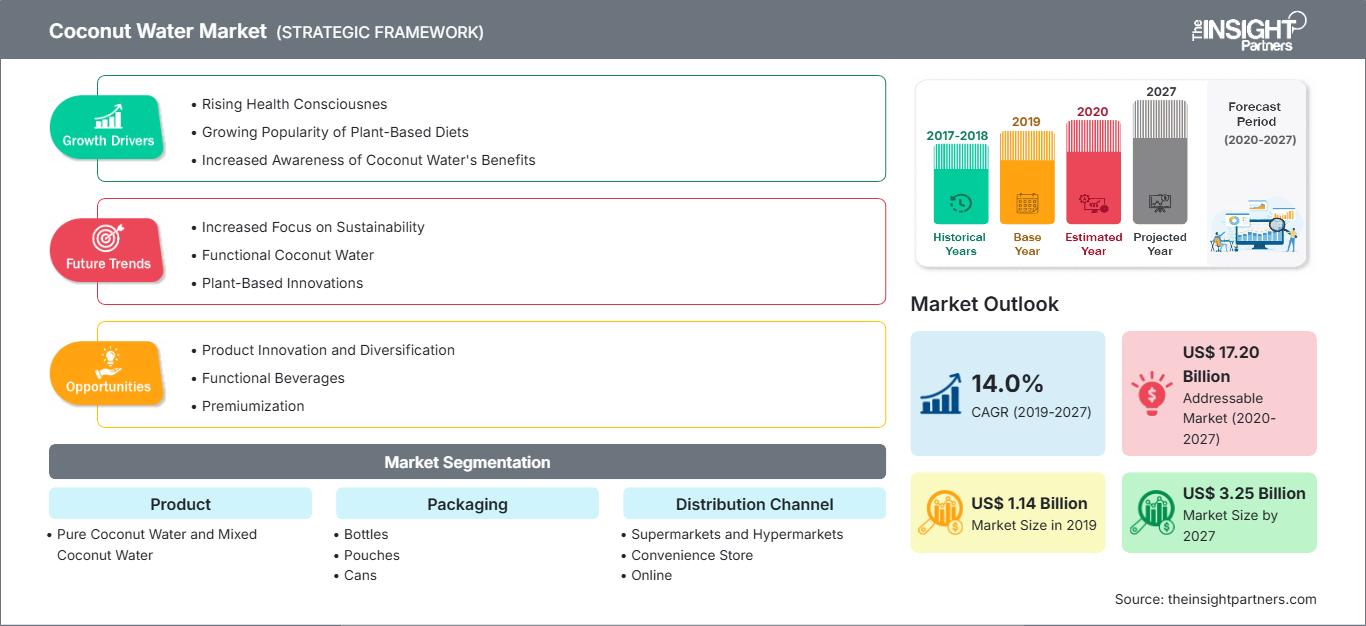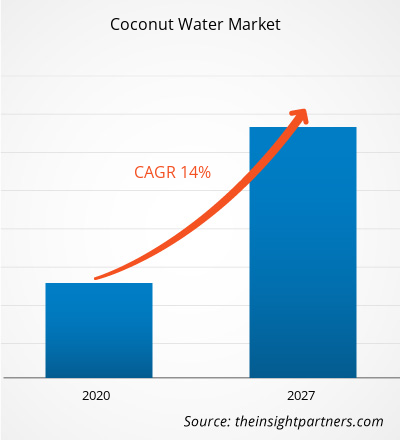Le marché de l'eau de coco était évalué à 1 142,09 millions de dollars américains en 2019 et devrait atteindre 3 246,64 millions de dollars américains d'ici 2027 ; sa croissance devrait atteindre un TCAC de 14,0 % entre 2020 et 2027.
L'eau de coco est utilisée pour fonctionnaliser et enrichir nutritionnellement une large gamme de produits alimentaires et de boissons, notamment les barres nutritionnelles, les céréales, les produits laitiers, les pâtisseries, les boissons, les en-cas, les sauces et les recettes de soupes. Elle est faible en calories et exempte de matières grasses et de cholestérol. Français Le marché mondial de l'eau de coco en Amérique du Nord devrait connaître une croissance annuelle composée (TCAC) maximale de 14,7 % entre 2020 et 2027. La consommation d'eau de coco augmente en raison des bienfaits pour la santé qui lui sont associés, ce qui stimule la croissance du marché.
La pandémie de COVID-19 a été signalée pour la première fois à Wuhan (Chine) en décembre 2019. En juin 2020, les États-Unis, la Russie, l'Inde, la Chine, l'Italie, la France et l'Allemagne figuraient parmi les pays les plus touchés en termes de cas positifs et de décès signalés. Selon les chiffres de l'OMS mis à jour en juin 2020, environ 7 482 952 cas confirmés et environ 419 497 décès ont été signalés dans le monde. L'épidémie a affecté les économies et les industries en raison des confinements, des interdictions de voyager et des fermetures d'entreprises. L'alimentation et les boissons sont l'une des principales industries mondiales souffrant de graves perturbations sous la forme de ruptures de la chaîne d'approvisionnement, d'annulations d'événements technologiques et de fermetures de bureaux. Bien que la Chine soit le centre manufacturier mondial et le premier fournisseur de matières premières pour diverses industries mondiales, elle est également l'un des pays les plus durement touchés par la pandémie de COVID-19. La fermeture de plusieurs usines et usines en Chine affecte négativement les chaînes d'approvisionnement mondiales, ainsi que la production et la vente de divers produits alimentaires et boissons. L'effondrement général du marché dû à cette épidémie freine également la croissance du marché de l'eau de coco en raison de la fermeture des usines, des obstacles aux chaînes d'approvisionnement et du ralentissement de l'économie mondiale.
Vous bénéficierez d’une personnalisation sur n’importe quel rapport - gratuitement - y compris des parties de ce rapport, ou une analyse au niveau du pays, un pack de données Excel, ainsi que de profiter d’offres exceptionnelles et de réductions pour les start-ups et les universités
Marché à l'eau de coco: Perspectives stratégiques

-
Obtenez les principales tendances clés du marché de ce rapport.Cet échantillon GRATUIT comprendra une analyse de données, allant des tendances du marché aux estimations et prévisions.
Aperçu du marché : Les bienfaits de l'eau de coco pour la santé stimulent la croissance du marché
L'eau de coco est exempte de cholestérol et de matières grasses. Elle est considérée comme une boisson sportive naturelle en raison de sa teneur élevée en électrolytes, notamment en potassium, calcium, sodium et magnésium, qui aident à réguler l'équilibre hydrique, à prévenir la déshydratation et à assurer le bon fonctionnement musculaire. Une teneur élevée en potassium favorise également la santé cardiaque et protège les consommateurs contre le risque d'accident vasculaire cérébral en réduisant la tension artérielle. Les professionnels de santé et les diététiciens recommandent aux patients de consommer de l'eau de coco plutôt que des boissons sucrées.
Aperçu des types de produits
Selon le type de produit, le marché de l'eau de coco se divise en deux catégories : l'eau de coco pure et l'eau de coco mélangée. Le segment de l'eau de coco pure représentait une part de marché plus importante en 2019. L'eau de coco pure, également appelée eau de coco biologique, est plus saine que l'eau de coco mélangée ou conventionnelle. Sous sa forme naturelle, elle est reconnue comme une riche source de sodium, de potassium et de magnésium, qui optimisent le processus de réhydratation.
Informations sur l'emballage
Le marché de l'eau de coco est segmenté en bouteilles, sachets et canettes. Le segment des bouteilles représentait la plus grande part du marché en 2019. Avec des formats allant de 50 ml à 1 l, les bouteilles sont l'une des options préférées des consommateurs et des fabricants. Les petites bouteilles sont faciles à transporter et permettent de stocker un volume suffisant d'eau de coco. Les bouteilles sont également faciles à transporter en vrac car elles ne s'abîment pas facilement. Les bouchons hermétiques prolongent la durée de conservation de l'eau de coco, ce qui stimule la demande mondiale d'eau de coco en bouteille.
Marché de l'eau de coco
Les tendances et facteurs régionaux influençant le marché de l'eau de coco tout au long de la période de prévision ont été analysés en détail par les analystes de The Insight Partners. Cette section aborde également les segments et la géographie du marché de l'eau de coco en Amérique du Nord, en Europe, en Asie-Pacifique, au Moyen-Orient et en Afrique, ainsi qu'en Amérique du Sud et en Amérique centrale.Portée du rapport sur le marché de l'eau de coco| Attribut de rapport | Détails |
|---|---|
| Taille du marché en 2019 | US$ 1.14 Billion |
| Taille du marché par 2027 | US$ 3.25 Billion |
| TCAC mondial (2019 - 2027) | 14.0% |
| Données historiques | 2017-2018 |
| Période de prévision | 2020-2027 |
| Segments couverts |
By Produit
|
| Régions et pays couverts |
Amérique du Nord
|
| Leaders du marché et profils d'entreprises clés |
|
Densité des acteurs du marché de l'eau de coco : comprendre son impact sur la dynamique commerciale
Le marché de l'eau de coco connaît une croissance rapide, portée par une demande croissante des consommateurs, due à des facteurs tels que l'évolution des préférences des consommateurs, les avancées technologiques et une meilleure connaissance des avantages du produit. Face à cette demande croissante, les entreprises élargissent leur offre, innovent pour répondre aux besoins des consommateurs et capitalisent sur les nouvelles tendances, ce qui alimente la croissance du marché.
- Obtenez le Marché à l'eau de coco Aperçu des principaux acteurs clés
- Eau de coco pure
- Eau de coco mélangée
Marché de l'eau de coco, par emballage
- Bouteilles
- Sachets
- Canettes
Marché de l'eau de coco, par canal de distribution
- Supermarchés et hypermarchés
- Supérette
- En ligne
- Autres
Profils d'entreprise
- Amy et Brian
- PepsiCo, Inc.
- The Coca-Cola Company
- C2O Pure Coconut Water
- Gracekennedy
- Green Coco Europe GmbH
- Harmless Harvest
- Mojo Organics Inc.
- Taste Nirvana
- Sambu Groupe
- Analyse historique (2 ans), année de base, prévision (7 ans) avec TCAC
- Analyse PEST et SWOT
- Taille du marché Valeur / Volume - Mondial, Régional, Pays
- Industrie et paysage concurrentiel
- Ensemble de données Excel
Rapports récents
Rapports connexes
Témoignages
Raison d'acheter
- Prise de décision éclairée
- Compréhension de la dynamique du marché
- Analyse concurrentielle
- Connaissances clients
- Prévisions de marché
- Atténuation des risques
- Planification stratégique
- Justification des investissements
- Identification des marchés émergents
- Amélioration des stratégies marketing
- Amélioration de l'efficacité opérationnelle
- Alignement sur les tendances réglementaires






















 Obtenez un échantillon gratuit pour - Marché à l'eau de coco
Obtenez un échantillon gratuit pour - Marché à l'eau de coco